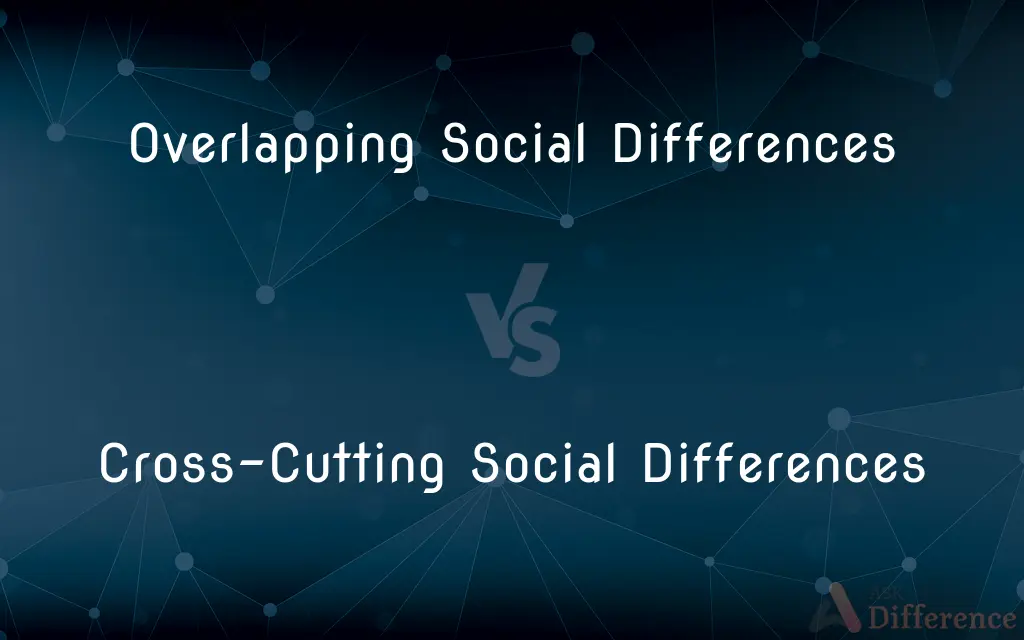Overlapping Social Differences vs. Cross-Cutting Social Differences — What's the Difference?
By Tayyaba Rehman & Maham Liaqat — Published on March 5, 2024
Overlapping social differences occur when social divisions align in a way that deepens inequalities, while cross-cutting social differences exist when groups share commonalities across divisions, reducing exclusivity and fostering cooperation.

Difference Between Overlapping Social Differences and Cross-Cutting Social Differences
Table of Contents
ADVERTISEMENT
Key Differences
Overlapping social differences are situations where different social divisions, such as race, class, and religion, align in a way that exacerbates social inequalities. For instance, when a racial or ethnic minority is also economically disadvantaged and follows a different religion from the majority, these overlapping differences can deepen social divides, making it harder for individuals to move beyond their disadvantaged positions.
Cross-cutting social differences, on the other hand, occur when social categories intersect in a way that individuals or groups share commonalities with others across different divisions. For example, members of a religious group might belong to various political parties, and people from different ethnic backgrounds might share the same socioeconomic status. These shared interests or identities can bridge gaps between different social groups, promoting understanding and reducing the potential for conflict.
The presence of overlapping social differences often leads to a deepening of social divides because individuals find themselves marginalized on multiple fronts. This can lead to increased feelings of disenfranchisement and can make social mobility more challenging. Policies aimed at addressing only one aspect of an individual's identity may not be sufficient to overcome the barriers created by overlapping differences.
Cross-cutting social differences have the potential to strengthen societal bonds by creating overlaps in group memberships. This diversity within groups means that people can find common ground despite other differences, facilitating dialogue and cooperation. Societies characterized by cross-cutting social differences are often more stable and less prone to conflict, as the multiplicity of identities and affiliations helps to diffuse tensions that might arise from any single source of division.
The impact of these social differences on a society depends significantly on the extent to which they are managed and addressed. In contexts where overlapping differences are prevalent, targeted policies that recognize and address the multifaceted nature of social identity are crucial for promoting equality and integration. Conversely, encouraging and nurturing cross-cutting social ties can be a powerful strategy for building a cohesive and resilient society.
ADVERTISEMENT
Comparison Chart
Definition
Social divisions that align and deepen inequalities
Social divisions that intersect, fostering shared commonalities
Effect on Society
Exacerbate social divides and inequalities
Promote understanding and reduce potential for conflict
Examples
A racial minority also being economically disadvantaged
Members of different ethnic groups sharing the same socioeconomic status
Impact on Individuals
Increased marginalization and challenges in social mobility
Greater opportunities for cooperation and understanding across groups
Policy Implications
Need for multifaceted policies to address compounded inequalities
Encouragement of diversity and cross-group interactions to build social cohesion
Compare with Definitions
Overlapping Social Differences
Aligning social divisions that compound inequality.
Low-income, ethnic minorities often face compounded challenges in education and employment.
Cross-Cutting Social Differences
Diverse affiliations that bridge societal gaps.
Cross-cutting political and religious affiliations can unify diverse groups.
Overlapping Social Differences
Can lead to social exclusion.
Overlapping racial and religious differences can isolate communities from mainstream opportunities.
Cross-Cutting Social Differences
Reduce exclusivity and conflict potential.
Shared economic interests across ethnic lines can mitigate potential tensions.
Overlapping Social Differences
Require comprehensive policy interventions.
Overlapping social issues in healthcare demand integrated policy solutions.
Cross-Cutting Social Differences
Encourage inclusive policies.
Recognizing cross-cutting identities can lead to more inclusive governance.
Overlapping Social Differences
Deepen societal divisions.
Overlapping social differences can perpetuate cycles of poverty and discrimination.
Cross-Cutting Social Differences
Foster social cohesion and dialogue.
Cross-cutting social networks in communities promote mutual understanding and cooperation.
Overlapping Social Differences
Marginalize individuals on multiple fronts.
Women in impoverished, rural areas suffer from overlapping gender and economic disadvantages.
Cross-Cutting Social Differences
Strengthen societal stability.
Societies with cross-cutting social differences exhibit higher resilience to conflict.
Common Curiosities
What are overlapping social differences?
Overlapping social differences occur when multiple social differences (like race, class, and religion) align in a way that compounds discrimination or privilege for certain groups.
What are cross-cutting social differences?
Cross-cutting social differences exist when social differences overlap in a way that individuals or groups share commonalities with different groups on various dimensions, reducing polarities and fostering inclusivity.
Can you give an example of overlapping social differences?
An example of overlapping social differences is when individuals from a minority ethnic group also belong to a lower socioeconomic class, intensifying their experience of social disadvantage.
Can you provide an example of cross-cutting social differences?
A scenario of cross-cutting social differences would be where individuals from different ethnic backgrounds share the same professional status or educational achievements, creating bonds across ethnic lines.
What are social differences?
Social differences refer to distinctions among people based on various factors like ethnicity, class, gender, religion, or culture that contribute to the diversity of societies.
Why are overlapping social differences considered problematic?
Overlapping social differences are problematic because they tend to exacerbate social inequalities, making it harder for affected individuals to overcome disadvantages.
How can cross-cutting social differences benefit society?
Cross-cutting social differences can benefit society by fostering understanding and cooperation among diverse groups, reducing conflict and promoting social cohesion.
How do cross-cutting social differences affect political systems?
Cross-cutting social differences can lead to a more stable political system by encouraging negotiation and compromise, as individuals find themselves aligned with different groups on different issues.
What impact do social media have on social differences?
Social media can both highlight and bridge social differences, depending on its use; it can facilitate the spread of divisive rhetoric or serve as a platform for dialogue and understanding.
How do governments typically address social differences?
Governments address social differences through policies aimed at promoting equality and inclusion, such as anti-discrimination laws, affirmative action programs, and multicultural education.
What role does education play in addressing social differences?
Education can play a critical role in addressing social differences by promoting awareness, fostering inclusivity, and equipping individuals with the skills to navigate and appreciate diversity.
How do overlapping and cross-cutting social differences influence individual identities?
Overlapping and cross-cutting social differences significantly influence individual identities by shaping experiences, perspectives, and the sense of belonging, impacting how individuals perceive themselves and are perceived by others.
What strategies can help mitigate the negative impacts of overlapping social differences?
Strategies include promoting inclusive policies, ensuring equitable access to resources and opportunities, and fostering dialogues and understanding between different social groups.
Can social differences lead to conflict?
Yes, social differences can lead to conflict, especially when they are overlapping and create distinct groups that are pitted against each other, leading to tensions and disputes.
Why is it important to understand the nature of social differences in society?
Understanding the nature of social differences is crucial for developing effective strategies to promote social justice, equality, and cohesion within diverse communities.
Share Your Discovery

Previous Comparison
Restraining Order vs. Order Of Protection
Next Comparison
Pendant vs. ChandelierAuthor Spotlight
Written by
Tayyaba RehmanTayyaba Rehman is a distinguished writer, currently serving as a primary contributor to askdifference.com. As a researcher in semantics and etymology, Tayyaba's passion for the complexity of languages and their distinctions has found a perfect home on the platform. Tayyaba delves into the intricacies of language, distinguishing between commonly confused words and phrases, thereby providing clarity for readers worldwide.
Co-written by
Maham Liaqat















































